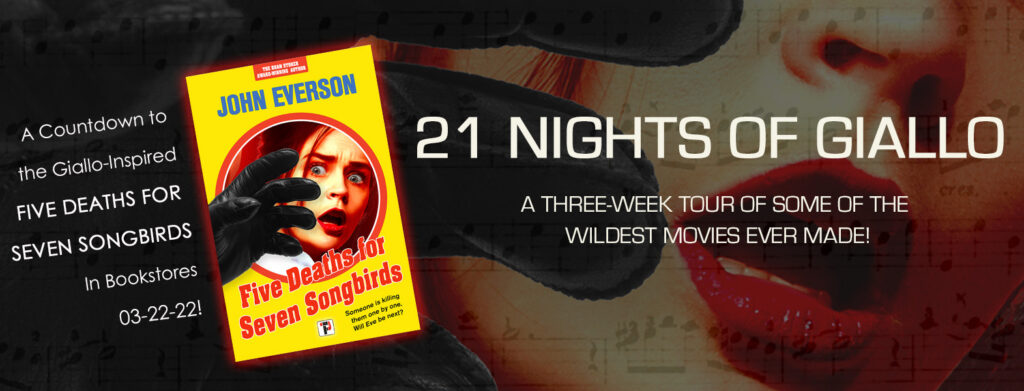
21 NIGHTS OF GIALLO continues with Week Two! I am reviewing a classic Italian giallo film every night in March, as a fun lead-up to the March 22nd release of my 13th novel Five Deaths For Seven Songbirds. I love giallo films, and my novel pays tribute to them… so I hope everyone who loves these movies like I do will check out the book. You can read last week’s film reviews, which covered films by Dario Argento, Umberto Lenzi, Lucio Fulci and Sergio Martino in the blog entry 21 Nights of Giallo: Week One. And now… on with Week Two, where we’ll cover four classics by Mario Bava and Luciano Ercoli and more:
We start the week with the original giallo by Mario Bava and end it by featuring one of his best and most influential:
NIGHT #14:
A Bay of Blood
Directed by Mario Bava
Screenplay by Bava, Giuseppe Zaccariello, Filippo Ottoni
Music by Stelvio Cipriani
(1971)
Mario Bava is considered to be the father of the giallo, and his latter career 1971 entry could be called the Hamlet of giallo! The body count in this grows fast – reaching 13 by the end! And there are all sorts of implements, from the eerie woman left hanging just three feet from the floor at the start, to a cleaver through the face to a couple speared through the middle while having sex (two for one!)
No poisons here; these murders are violent. You can definitely see how this film influenced the start of American slashers like Friday the 13th. And yet somehow, a lot of the movie still has more of a gothic vibe than most ‘70s giallo films, likely because of Bava’s long film career which included a number of ‘60s gothic horror films.
Opening with melancholy music and an old woman reflecting in her wheelchair, we’re introduced to the story with the sudden murder of the Countess by her husband Filippo. But no sooner does he plant a suicide note, then he is stabbed to death and dragged away. What’s going on here?
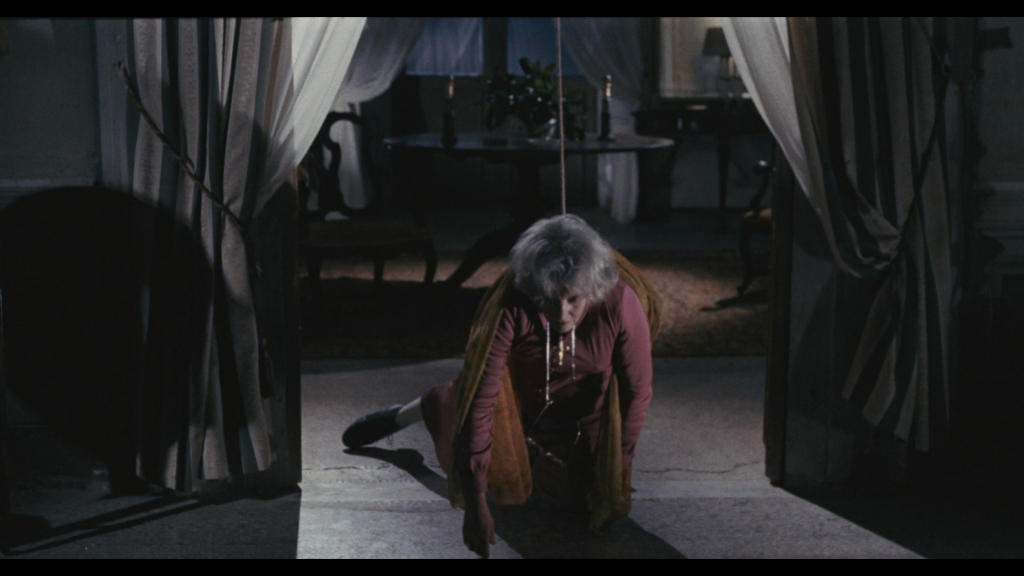
Things quiet down for a bit as we meet a few other characters, including an oddball bug collector who is firmly against having the bay developed into a resort area (it will chase out the bugs!) and his cornball tarot-reading wife. We also meet the land developer Frank Ventura and his girlfriend, and the countess’s illegitimate son, a local octopus trapper named Simon. And soon Filippo’s daughter Renata (Claudine Auger, the Bond girl of Thunderball) and her husband Albert (played by Luigi Pistilli, who giallo fans will recognize from Your Vice is a Locked Room and Only I Have the Key), arrive back in town to investigate what has happened to her father. Renata is a great hard-willed character who really propels the second half of the film.
We also meet four hippies who arrive in a dune buggy and discover an abandoned resort area with a club and an overgrown swimming pool. But when one of the girls takes a nude swim in the bay and uncovers the body of the missing Filippo… the body count swiftly begins to rise.
The rapid series of deaths keeps the plot on this one moving fast, but you gather early on that all of this has something to do with Frank Ventura’s scheme to redevelop the bay as a resort location. The “dune buggy” kids give the film its requisite gratuitous nudity and in one scene, we get a two-for-one kill as two people making love are both speared with a single shot (a foreshadowing of Friday the 13th Part 2?).
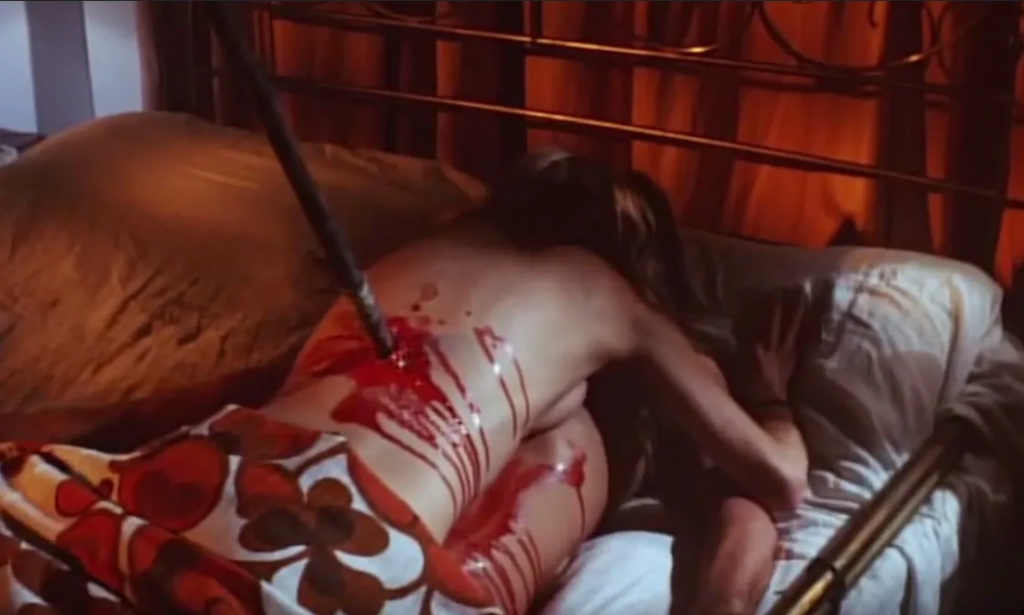
There’s also a great shock scene of bodies in a bathtub that will stick with you, and the final ending sequence will make your eyes go wide as you laugh and are shocked at the “just desserts” horror of it at the same time.
Bay of Blood is a great giallo with cinematography that keeps one foot in old traditional ‘60s film, but with its kills and plot bring Bava firmly into the ‘70s era of the giallo. Fans of horror slashers and giallo should absolutely have this in your watch list. And it’s easily available on DVD from Kino Lorber and currently streaming for free on Amazon Prime.

9 out of 10 black-gloved fingers!
Today, March 13th, is the 26th anniversary of the death of Italian auteur Lucio Fulci, so tonight I thought we should revisit one of his critically acclaimed gialli:
NIGHT #13:
Don’t Torture a Duckling
Directed by Lucio Fulci
Screenplay by Fulci, Roberto Gianviti, Gianfranco Clerici
Music by Ritz Ortolani
(1972)
With a cast of characters and suspects including a rich girl who seems to delight in sexually tantalizing young boys (and priests), an eccentric hermit who practices black magic, a disturbed gypsy woman who also indulges in voodoo doll making in the hills outside of town and a village idiot who spies on prostitutes, Don’t Torture a Duckling definitely amps up the “what the heck is going on?” factor. Frequently listed among Lucio Fulci’s best films, it certainly has great cinematography and a plot that will keep you guessing.
For my money, A Lizard in a Woman’s Skin far surpasses it, but Duckling is an interesting oddball of a giallo. Unlike most, this slow-building mystery occurs in a backwater Italian town in the hills called Accendura. It’s a rural place populated by superstitious working class people with a couple of “witches” who live in the hills outside of town. Unlike most giallo that center on the moral turpitude of the bourgeois, this is not a story filled with beautiful faces, vengeful businessmen or fashion models. The townspeople are all in well-worn clothes and often look sweaty and dirty, with the exception of Barbara Bouchet (The Red Queen Kills Seven Times), who plays a city girl who’s gotten into trouble with drugs in Milan, and thus has been sent to “dry out” to Accendura by her rich father.
The film opens with a disturbing scene: La Magiara (Florinda Bolkan, Flavia the Heretic) is digging with her hands in the dirt on a hill outside of town, overlooking a modern freeway. And as her hands move through the dirt, she unburies the bones of a human infant.
Soon after we meet a trio of boys, Bruno, Tonino and Michele, who enjoy taunting the village idiot, Giuseppe, as he tries to spy on prostitutes who take men to a small hut on the hill. “Peeping Tom, Peeping Tom, we know what you’re watching,” they call.
One of those boys, Michele, soon is taunted himself. When he takes a glass of juice upstairs to Patrizia (Barbara Bouchet) who is tanning in the nude, she flaunts her nakedness at him and bids him come closer to look.
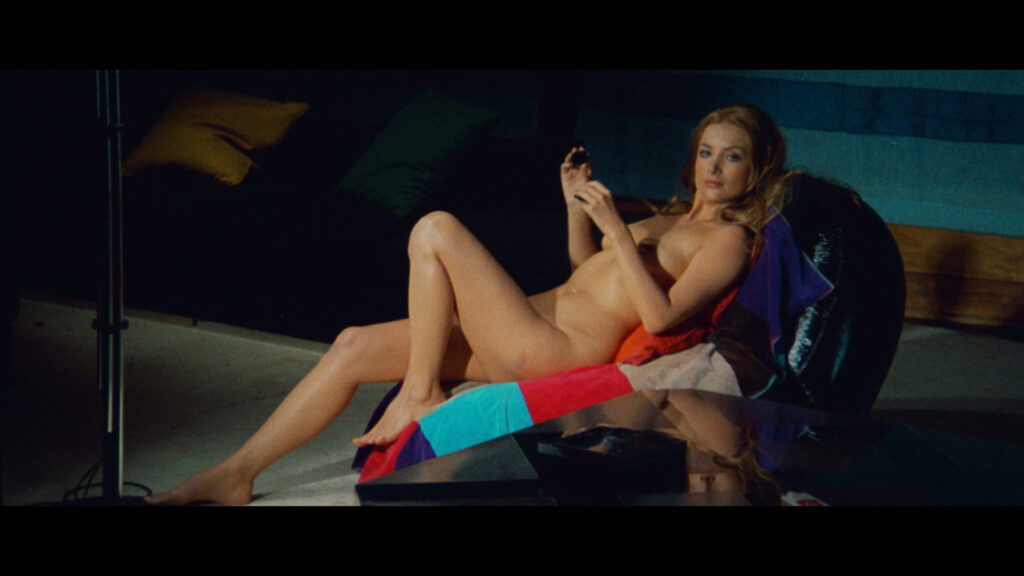
Early on, we see flashes of someone’s hands as they fashion three wax voodoo dolls and stick pins in them. And then… we see Bruno chased through the woods in a storm and struck on the head. And so begins a long road of detective work for reporter Andrea Martelli (Tomas Milian, The Designated Victim), who first is on the scene trying to cover the search for the missing boy for his newspaper, then to try to unravel a kidnapping ransom demand and finally to find out who is behind what turns into a string of murders, as all three of the boys turn up dead one by one. He’s helped by the young village priest, Don Alberto Avallone (Marc Porel) and eventually by Patrizia, who has ulterior motives… she seems to be “driving around” every time one of the murders happens and is one of several suspects.
In the end, Fulci does a great job at setting us up to choose the wrong person as the killer, and the final revelation is perfectly played.
Don’t Torture a Duckling features some great camera work, including a chilling shot of a drowned boy found outside in a cement tub. We get a couple of “lynch mob” style scenes, demonstrating the “backwater” mentality of the townsfolk; at one point someone notes, “We construct gleaming highways but we’re a long way from modernizing.”
There is some commentary as well on the tension between the Church and black magic and superstition. There’s a relentlessly cruel “revenge” scene played on one of the suspects that is tough to watch; this and the ultimate end of the killer shows the start of a trend of “gory” effects for Fulci that would grow as the ‘70s wore on.
It’s a good film, but for me, it takes a little too long to gel, probably because Fulci tries to make everyone a suspect. The soundtrack is also offputting for me, with lots of symphonic flourishes that sound like they should be in a big studio dramatic romance movie. When those symphonic cues aren’t playing, there is a lot of background flute music going on, which sounds almost like American Indian instrumentals. It’s all just not really the kind of soundtrack to build tension the way you’d expect in a giallo.
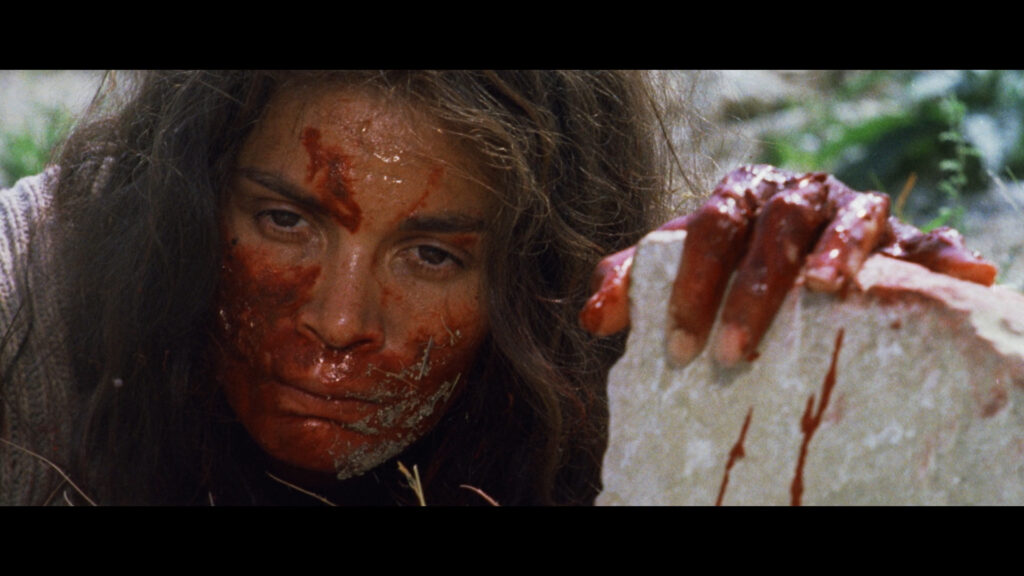
Florinda Bolkan gives a great performance as the witch, ending one particularly over-the-top emotional outburst by foaming at the mouth on the floor. There’s a scene where she is climbing a rocky hill to escape the rural cruelty and reach the civilization promised by the highway that is chilling to watch. That scene and Bouchet’s cruel nude taunting scene of Michele are probably the best moments in this one for me.
You can get this one on disc from both Blue Underground and Arrow Video and stream it on Amazon Prime.

7 out of 10 black-gloved fingers!
NIGHT #12:
Death Walks At Midnight
Directed by Luciano Ercoli
Screenplay by Ernesto Gastaldi, Guido Leoni and Mahnahen & Mannuel Velasco
Music by Gianni Ferrio
(1972)
Death Walks at Midnight is the third and probably the best of the Luciano Ercoli giallo films (and they’re all good!) As in his first two, Death Walks on High Heels and The Forbidden Photos of a Lady Above Suspicion (reviewed below), he used a Gastaldi script and cast his wife Susan Scott as the lead, a fashion model named Valentina, and Simón Andreu as her friend. Andreu plays Giò Baldi, tabloid newspaper reporter, who convinces Valentina to take a hallucinogenic drug so that he can document the results in an expose article. While he promises to hide her identity in photos with a blindfold, once she’s under the influence, he removes it “for better photos” and thus, her image is all over the city shortly thereafter (leading to a rift between them).
The pictures are important because while under the influence, she sees a murder being committed across the courtyard – a man in dark glasses bashing in the side of a woman’s face with a metal spiked glove. Giò publishes the description as part of the story, thinking its all just hallucination… but… when it’s discovered that a murder just like this one occurred in that same apartment six months earlier, and a strange man keeps following her on the street telling her she’s in danger, we know (even if Giò, her boyfriend Stefano, and the police don’t) that something more is afoot! And the killer knows her identity thanks to the article.
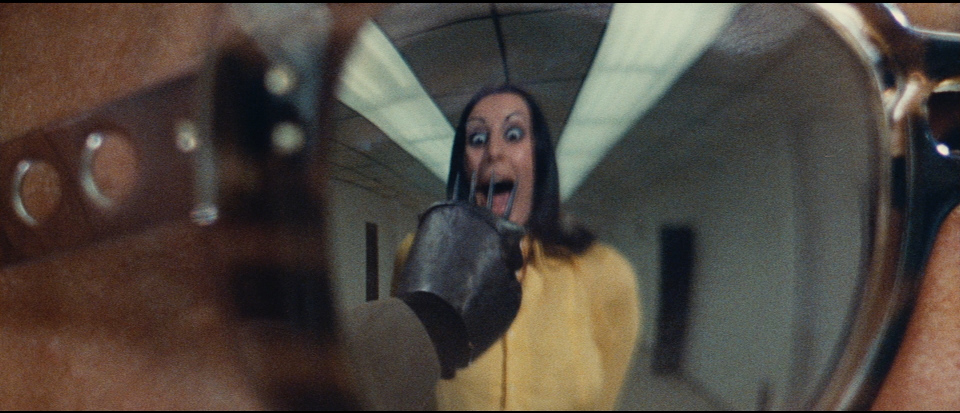
Soon the man in dark glasses keeps showing up outside of windows wherever Valentina goes, and at one point, she and Giò try to chase him down a busy street. But he is an elusive killer despite many appearances!
There’s a great scene where she gets a letter inviting her to do a modeling job and she shows up at the address and goes up to find that it’s actually the same apartment across from her own where she saw the murder. Soon a metal spiked fist is punching its way through the locked door and she’s frantically trying to get her boyfriend Stefano’s attention across the street (played by Peter Martell, from the French Sex Murders). He can’t hear her due to his stereo but eventually she uses a mirror and reflected sunlight to catch his eye.
Verushka (Claudie Lange, also in Death Walks on High Heels), the sister of the girl murdered six months before, soon enters the picture as an enigmatic figure. She takes Valentina to see the man arrested and put in a psychiatric ward for the murder… but Valentina realizes that it’s not the same man… nor was the sister the victim she saw killed. And then one of the doctors from the institute corners her and tells her to stay away from Verushka… why?
Who dunnit? There are lots of fun sideplots and red herrings in this one, and the end twist – which ends with a rooftop fight and chase by two drug smugglers who enter the plot mid-film – is wickedly fun. If you like a good mystery thriller with plenty of 1970s kitschy décor (from those classic fiber optic filament light fixtures to a round bed), this one will keep you locked in.
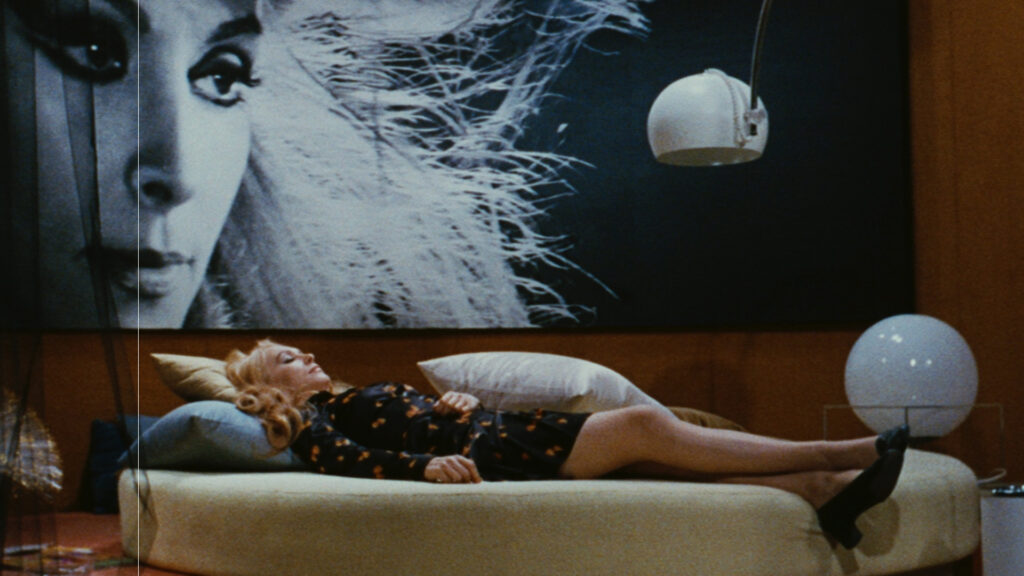
The cinematography is great with some arty framed shots, including one moment where Valentina is checking her makeup and sees the killer in the compact mirror behind her.
There are scenes at a jazzy nightclub and a hippie drug party spearheaded by a wildly stereotypical gay photographer who quips that he is so drunk “even the girls are looking good!” You’ve gotta smile at the dated ’70s sexual politics of the photographer and Stefano’s attitude towards women – he tells her at one point that “she just needs to have kids.”
This one’s available from Arrow on DVD, blu-ray or as part of a two-disc Death Walks Twice box set paired with Death Walks on High Heels (which is what I own – highly recommended!)

9 out of 10 black-gloved fingers!
NIGHT #11:
The Fifth Cord
Directed by Luigi Bazzoni
Screenplay by Bazzoni, Mario di Nardo, Mario Fanelli
Music by Ennio Morricone
(1971)
The first thing you’ll notice about The Fifth Cord is the camera work, and that’s not an accident. Future Oscar-winning cinematographer (for Apocalypse Now) Vittorio Storaro is behind the camera for this (he lensed Dario Argento’s The Bird with the Crystal Plumage just prior) and he pulls out all the visual stops here.
Opening with the recording of a man whispering in a maniacal monologue about how he intends to murder, the camera travels through almost a carnival maze of scenes spotlighting various people before winding on and finally settling on the end of a New Year’s Eve party. A party, where it turns out, many of the key players in the film were celebrating. The Fifth Cord starts off with a visually unsettling vibe and Storaro’s use of stark urban landscapes, partially obscured character shots and killer-point-of-view camera perspectives continue to raise that ante throughout the film.
But what’s it about?
Franco Nero (Django) stars as Andrea, a washed up journalist who seems to have as many problems with women as he does with the J&B bottle. He leaves the opening New Year’s Eve party in a drunken haze, while a short while later, one of the other attendees is assaulted in a tunnel. Two bystanders making out in the tunnel hear the attack and one of them, a race car driver who turns out to be the brother of Andrea’s mistress (just the first of many strange character connections) gives unsuccessful chase. The victim survives and Andrea writes the story about the assault for the newspaper after spending some time trying to interview the doctor and the couple who witnessed the attack.
Not long after, when the wheelchair-bound wife of the doctor (also one of the NYE partygoers) is strangled and thrown down the stairs, Andrea takes on the case again, and soon seems to be doing more investigative work than the police. But he quickly has reason to, since he is also a suspect. By the time of the third murder, it’s clear that Andrea seems to constantly be in the wrong place at the wrong time… and never has a good alibi.
The film took awhile to kick in for me the first time I watched it. There are a lot of broken and twisted character relationships to try to follow, and several characters who might have reasons for doing the others in.
Meanwhile, at each crime, a glove is discovered missing first one finger… then two… then three… It’s a great setup and certainly keeps the viewer guessing.
But in the end, the killer’s motive doesn’t really give the “ah-ha!” moment you’d like to feel. The explanation for the past 90 minutes really goes by in a flash with no prior clues having been there to have allowed the viewer to guess the motive.
It’s not satisfying.
That said, the film is certainly one of the best-shot giallo ever made.
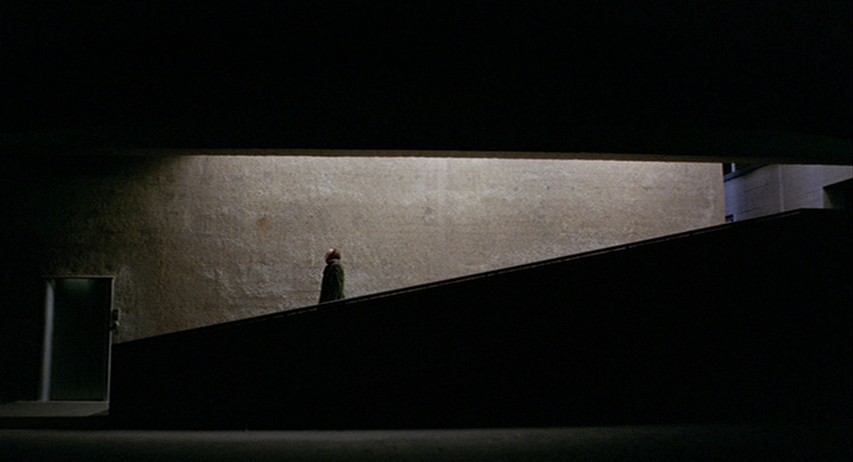
The second time I watched it, I began to realize that Andrea’s feelings of alienation and isolation were reflected in the way the city and Nero are shot. Long shadows in dark tunnels. Wide angles of urban decay.
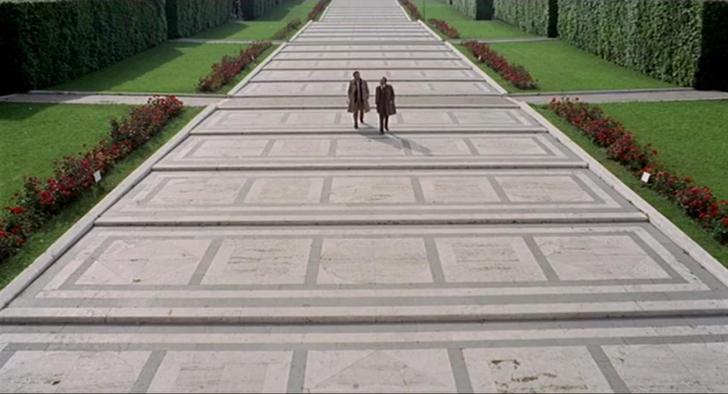
There are gorgeous long shots of him walking down a geometric city park path, and in one scene, as Andrea chases someone down stone outdoor theater style steps, it looks as if he is standing in mid-air. The entire backdrop behind him is of wide white stone steps, with nothing else in the frame. He looks suspended against rock. It was striking enough, I had to mention it here!
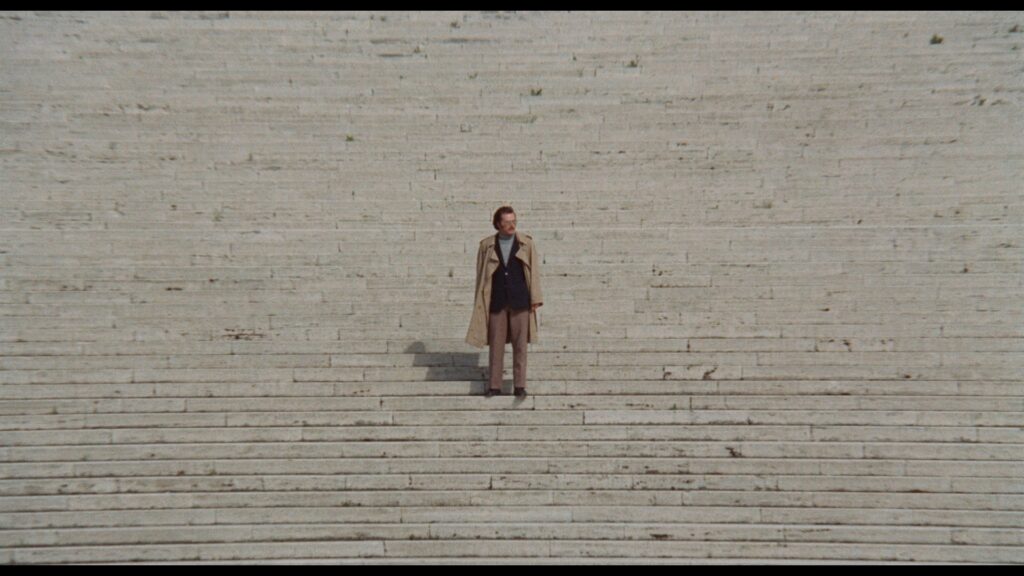
There are a lot of shots like that in the film, and a continual use of characters being masked by window shades, glass with reflections on it obscuring the character’s faces, and characters who are completely backlit, showing only as silhouettes on screen. They’re all visual metaphors that suggest characters trapped in urban isolation, characters who are “lost” and perhaps that the truth of everyone is hidden, masked by layers of light and shadow. It’s truly striking, and worth watching the film for that reason alone.
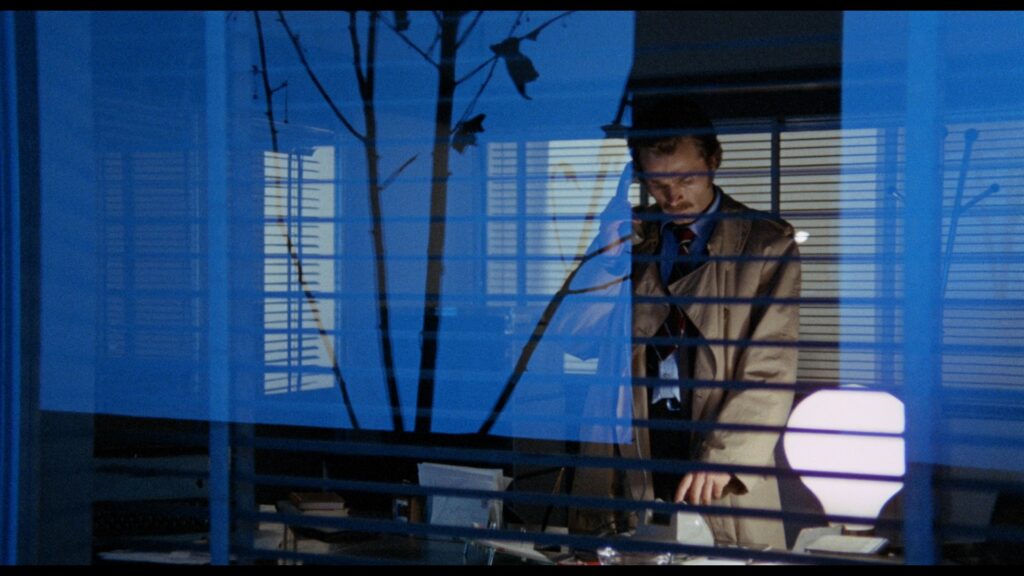
At one point, we even see a “peeping Tom” watching a prostitute in the park… only to have the camera fade back to show that there’s another peeper behind him… layers, again.
The Fifth Cord is well-made, and while the soundtrack is somewhat sparse, it features an organ-dominated jaunty opening theme by the omnipresent Ennio Morricone.
In the end, I enjoyed it but it’s not one of my favorite giallo films. Nero gives a convincing performance, but Andrea is not the easiest character to identify with, and there’s an aura of fatalism and isolation that pervades much of the film due to the settings and the character flaws of each of the victims and potential suspects. And the payoff at the end just wasn’t there for me. That said, it is absolutely worth a look for the cinematography alone.
You can catch this on DVD from Blue Underground or stream it on Amazon Prime.

7 out of 10 black-gloved fingers!
NIGHT #10:
The Police Are Blundering In The Dark
Directed by Helia Colombo
Music by Aldo Saitto
(1975)
Italian with English subtitles
Not only are the police blundering in the dark in this film… they’re completely in the dark – I don’t think a cop appears until the final scene!
This is not a top-shelf giallo, and director Helia Colombo apparently didn’t sit in a director’s chair again after it, but the film does offer some quirky moments and twists. The Police Are Blundering In The Dark centers around a series of scissor-stabbing killings of female models, and the search by Giorgio (Joseph Arkim), a journalist, to track down the killer after his female friend goes missing after borrowing his car.
The opening credits roll over a bloody pair of scissors discarded to the green forest ground as a beautiful string score plays. The first scene gives us our first kill, as a woman gets flat tire on a country road, is confronted by a killer and runs across the field with her shirt ripped open before meeting her scissored end.
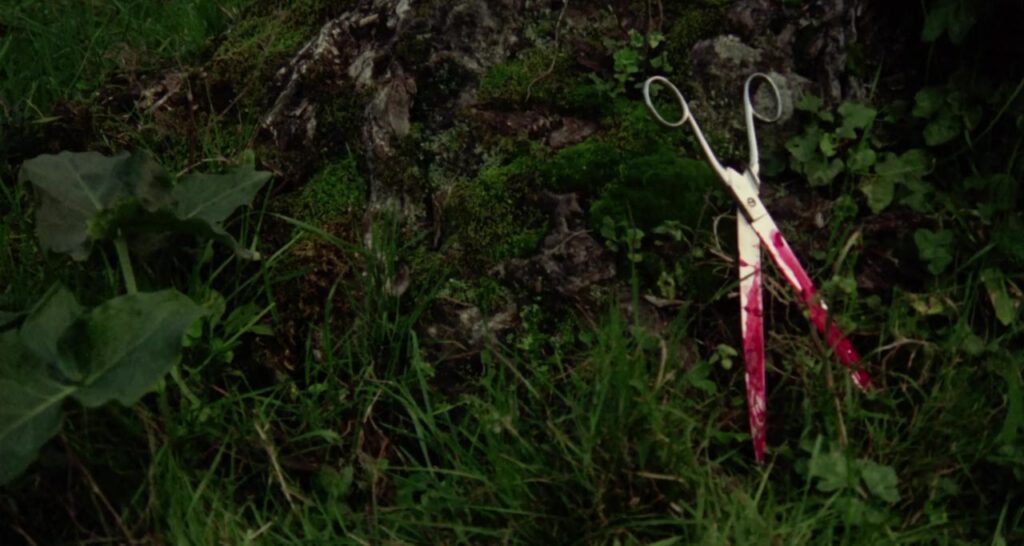
We quickly get the summation of where things stand – a newspaper clipping is show that says: “Another model missing – four in 18 months – the police are blundering in the dark.”
With our “setup” out of the way, the film really begins when Erika, a model on her way to meet a famous photographer, Parrisi, has her borrowed car break down and is stranded at a creepy inn where all of the denizens stare a lot. Picture Deliverance set in Europe.
She calls him, but Giorgio refuses to come help her because, well, he’s in bed with another woman (a trend for him in this film) and so Erika has to stay the night at the inn. But when our playboy Giorgio finally turns up to pick her up the next day… she’s missing.
We know, from the long, lingering shots of her eating a ham sandwich in the nude the night before, exactly what has happened. But there is no body found…
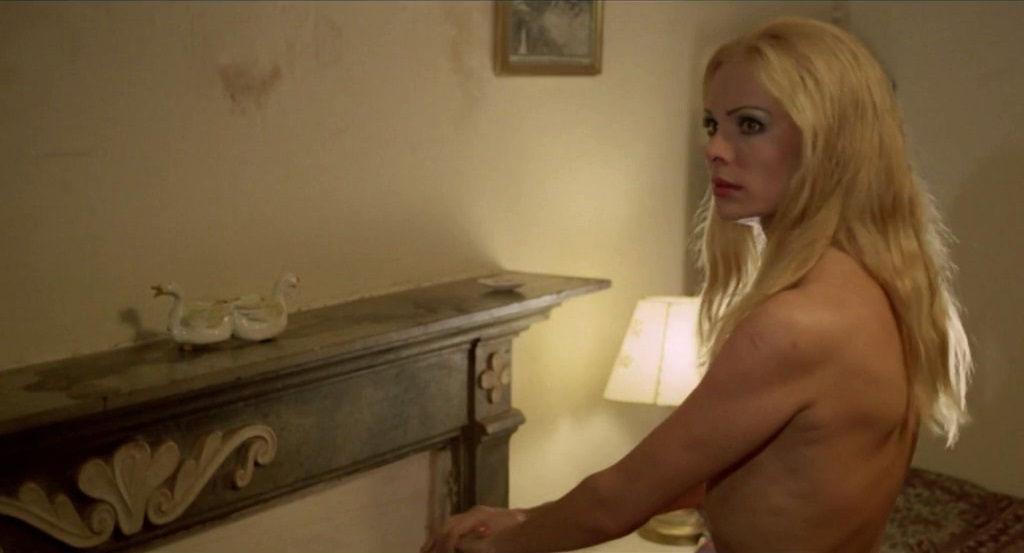
Giorgio’s search leads him to Parisi, a wheelchair bound photographer, who Erika was on her way to meet. Giorgio is invited, first to dinner, and then to spend the night when the weather gets bad, and finds amorous attentions from just about every female in the house. Everyone seems just a bit too wound up and repressed in this villa!
Despite plenty of gratuitous nudity and two kills in the first hour, the first half of the film plays slow. Long stares and lots of roaming eyes from various characters and a way-too-long dinner scene don’t help, nor does the soundtrack, which plays like elevator music.
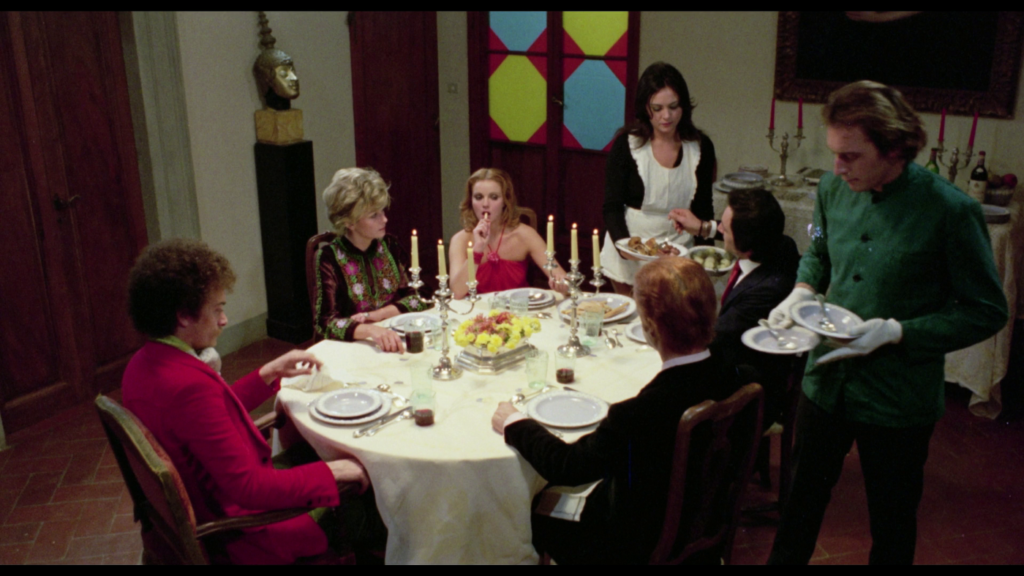
We are kept as much in the dark as the police about what is really going on, but clearly it all centers around Parisi. His wife, his niece and his maid (pictured around the back half of the table) all talk of being trapped at the estate (and all are desperate for a man!) There are mentions of “erotomania” when the butler holds a consultation about one of the characters (we don’t quite know who) with a psychiatrist, and ruminations like “Love is like a downpour on a summer day; it hits when you least expect it.”
There are certainly an array of oddball characters and situations to keep your interest. We get: a doctor with an obsession for vegetables and flowers; a butler who ruthlessly blocks the maid from liaisons; the photographer’s wife who is apparently raping his niece; the aforementioned creepy inn-keepers (including a mute) and the one thing that throws off the film for me – a sci-fi plot device revolving around taking pictures of people’s thoughts. That ostensibly plays into the unmasking of the killer, but really… it’s ultimately unnecessary and leads to a sequence with sci-fi music and a spaceship-looking console that is totally out of 1960s drive-in movies that kills all the tension because it is just kind of comical.
There’s also an end sequence of an airplane flying over the city that has absolutely nothing to do with the events of the film. Bargain basement film-making here.
All that said… there are some fun scenes in this one that keep you watching, and I’m glad I own it because I will probably revisit it because of that. This one’s available on disc as part of the Forgotten Gialli: Volume One box set from Vinegar Syndrome.

6 out of 10 black-gloved fingers!
NIGHT #9:
The Forbidden Photos of a Woman Above Suspicion
Directed by Luciano Ercoli
Screenplay by Ernesto Gastaldi
Music by Ennio Morricone
(1970)
Director Luciano Ercoli left his 1960s spaghetti westerns behind and shot three solid giallo films from 1970-1972, all starring his future wife Nieves Navarro (billed as Susan Scott) and written by Ernesto Gastaldi. The Forbidden Photos of a Lady Above Suspicion was the first and raciest (perhaps later once they became ‘an item,’ he didn’t want to show off her assets publicly quite so much!).
The film opens with Minou having a monologue with herself while smoking in the tub. Minou (played with perfect naïve innocence by the striking Dagmar Lassander from Mario Bava’s Hatchet for the Honeymoon) is a beautiful redhead who muses: “I’m going to give up cigarettes today. And I’m going to stop drinking. And I’m not going to take any more of those tranquilizers…”
The next 90 minutes will prove these all to be false promises!
Soon the warm, rich tones of an Ennio Morricone score build and set a period mood as Minou dresses, paints her toenails and considers the idea of taunting her husband Peter (Paolo Capponi, from Argento’s Cat O’ Nine Tails) with the threat that she is seeing someone else – so that he’ll pay more attention to her. She even loosens the front strings of her dress to be less “house-wifey.”
Ironically, immediately afterwards, those strings will be violently cut when she’s walking down a beautifully shot night-blue beach and a rogue motorcyclist shows up to chase and molest her (Simon Andreu, who also appears in Ercoli’s Death Walks on High Heels and Death Walks at Midnight). He accuses her husband of being a murderer, but after his sexual threat by his weapon of choice for the film (a knife on a stick), he abruptly disappears.
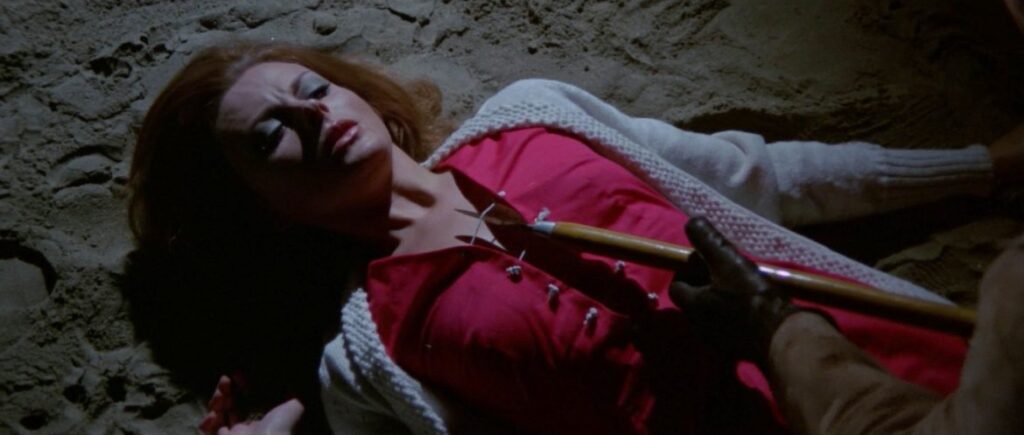
Shortly thereafter, we meet Minou’s libertine friend Dominique (Susan Scott, who would return with Andreu in Death Walks on High Heels and Death Walks at Midnight). Dominique is a strong, independent woman who acts like a decadent and experienced “older sister” figure to Minou. She makes plenty of comments about sex and likes to show off her own nude photos to her friend, as well as her pornographic pictures bought in Copenhagen. Ercoli and Gastaldi set up a bit of a triangle here… since Dominique apparently had a thing with Minou’s businessman husband Peter back in the day. Does she aim to steal him back?
The accusations of the biker stick with Minou, since her husband is having financial problems with his business. Then, one of the financiers he owes money to turns up drowned, with symptoms of the bends – as if he was diving. When Minou stops by Peter’s business and finds them experimenting with pressure chambers for divers… well, we and she can both put 1+1 together. So now she’s scared and soon entrapped, bound and raped by the biker who claims to have evidence of the murder. And, perversely, it seems that she may have enjoyed the forced situation, though she denies it.
So we’re quickly set up to think that Peter is a murderer and Minou is an innocent caught in his deceptions… but later, as the film goes on and the police are involved, we start to question whether those tranquilizers chased with liquor are clouding her perceptions… or at least, that seems to be what everyone else in the film thinks.
Despite the racy subject matter and the cheesecake photos we do see of Susan Scott, Forbidden Photos actually keeps the nudity in check more than later giallo films. It features some rather striking cinematography, ranging from the night beach scene to the jazzy night club to a wonderful shot where Minou pulls her tormentor’s curtains aside and has her face cast in a horizontal light.
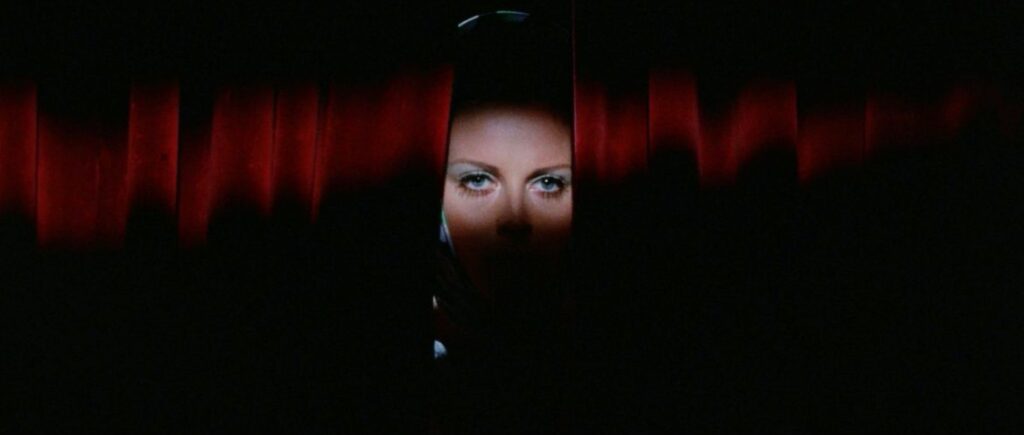
The costume design is striking too – Dagmar Lassander’s wardrobe is always upscale stylish (in a 1970 European flair!) and just the right vibrant color to really bring out the orange of her hair and sapphire eyes.
There are some great setpieces too, from a turtle that turns up periodically just to push shoes around and wild art in the biker’s apartment (from disembodied finger statues to a red Chinese devil).
And while some of the dialogue seems just a hair wooden, there are some great lines like when Minou avoids reporting the biker because, “the police just make you fill in forms” and when the biker derides the upper class (as many giallo do), sneering, “Both of you think that your money can buy anything… you’re worse than animals.”
You may see through a couple of the red herrings, but even if you do, you’ll likely be surprised by the way it all plays out. This is a solid, stylish giallo that is worth visiting more than once. You can easily grab this on disc from Blue Underground or Arrow or stream it via Amazon Prime for a rental fee.

8 out of 10 black-gloved fingers!
NIGHT #8:
The Girl Who Knew Too Much
Directed by Mario Bava
Story by Ennio de Concini
Music by Roberto Nicolosi
B/W
(1963)
It’s time to go back to where it all began…
Mario Bava’s The Girl Who Knew Too Much is credited as being the first giallo film (an alternate edited version was released originally in the U.S. as Evil Eye). That “first” designation makes it a little hard to watch because of the expectations that latter day giallo set; when I hear the word giallo, I think razor-wielding psychopaths and gruesome technicolor slashing murders. The Girl Who Knew Too Much is going to feel very Rated G tame compared to what you’d be expecting after an Argento or Fulci giallo from a decade later. That said… all the trappings are definitely here. We get:
- a short (ABC) series of “alphabet murders” where the killer appears to be selecting victims based on their last name.
- a woman on her own traveling to Rome who turns amateur sleuth trying to solve the murders before she becomes the next letter in the alphabet burial ground.
- our heroine stalked by the killer when she gets a little too close to unraveling the mystery
- several potential suspects to choose from, and
- a surprise twist at the end.
So you see that of the now-familiar giallo trappings are undeniably here; it just looks more like a film noir mystery than what we usually expect from what the giallo ultimately became known for. So what’s it actually about?
Nora (Letícia Román) is on her way to visit her sick aunt, and accepts a cigarette on the plane from her seatmate. When he is arrested for drug smuggling as soon as they hit the ground, the viewer (and Nora) are put instantly off-kilter. And Nora’s run of unfortunate situations begins. That night, she meets an attractive doctor who warns her about her aunt’s condition but assures her everything will be fine. Well… it’s not, and later, when her aunt dies and the phone line goes out, Nora runs through unfamiliar dark streets to try to find the doctor at the nearby hospital. But… instead of reaching him, she is mugged and left unconscious on the cobblestone of the beautiful Piazza di Spagna.

Later, she wakes up just in time to witness a knifing murder happen across the courtyard… but then she falls right back unconscious from the mugging trauma so that even the subsequent rain doesn’t wake her. The following morning, a drifter tries to jolt her awake with a shot of booze, but he disappears when a policeman turns up. She describes the murder to the cop, but with booze on her breath, a knock on the head and no body to be found anywhere… she’s dismissed as delusional.
It’s not exactly a good first day in Rome.
Soon she is carrying on with the doctor, Marcello (John Saxon) and connects with a friend of her aunt at the funeral, who invites her to stay at her house while she goes off to meet her husband out of town. Things seem to be looking up…. Until Nora meets a reporter who clues her in that there WERE murders in the area as she describes. Soon after, she finds a newspaper clipping that describes the ABC murders, and when she answers the phone as Nora Davis, someone on the other end asks, D as in Death?
Uh oh!
There is some great cinematography in this one, from the spooky rain-wet reflections on the street during the initial murder to a scene where Nora jerry-rigs the house that she is staying in with string and talcum powder to foil any break-in attempts. And one scene finds Nora walking down a long, disturbingly empty white corridor with hanging lights swinging lazily overhead as a disembodied voice threatens her from an unseen room. That one, in particular, hints at some of the elaborate, stylish “tension-setting” scenes of future gialli.
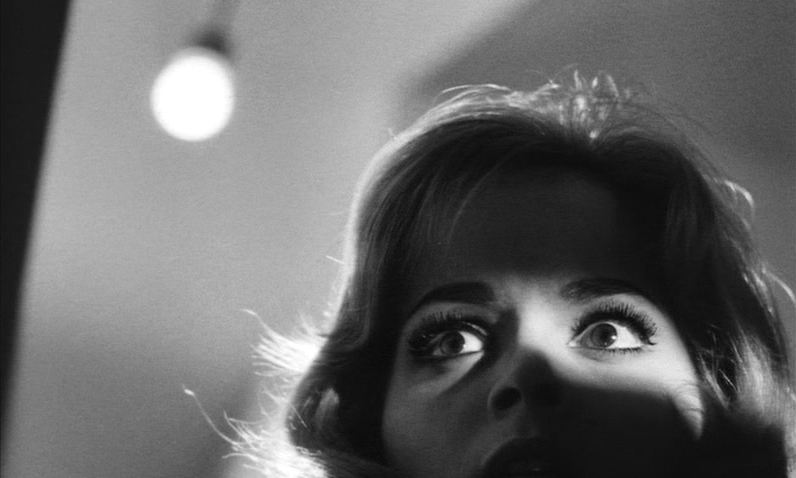
There are some humorous bits too; Nora is responsible for breaking Marcello’s finger, and every time he tries to help her, she manages to whack his hand somehow. And when she wakes after her initial mugging in a hospital with nuns leaning over her, she asks woozily, “Am I in heaven?”
If you like classic films, noir and giallo, this is definitely one to watch. It’s certainly dated, but still entertaining. Just don’t look for the gratuitous nudity and gallons of blood that would come to define the genre it helped spawn in the ‘70s, and which would begin to surface in Bava’s next film, the color giallo Blood and Black Lace which centers around the sex maniac killings of fashion models.
You can get this one on disc in various editions from Image, Arrow or Kino.







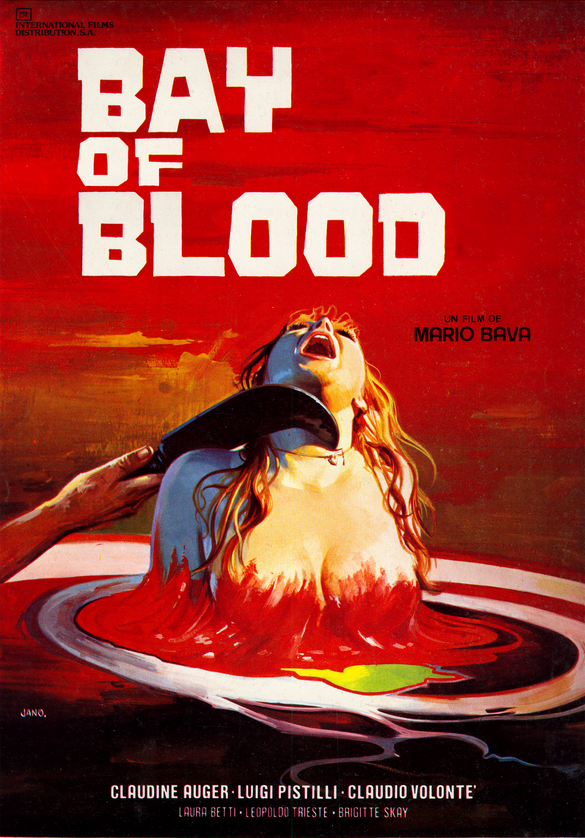
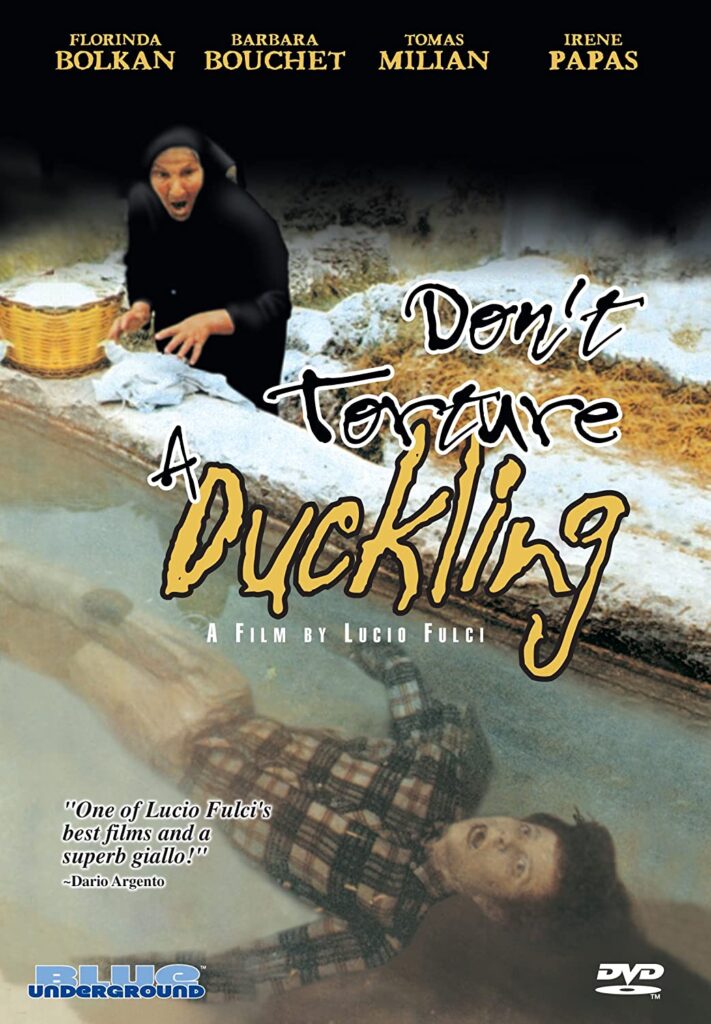
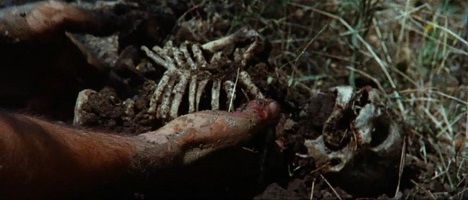
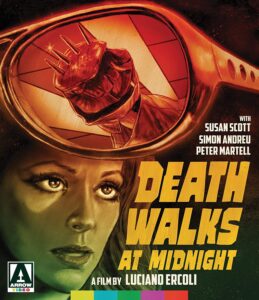
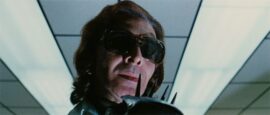
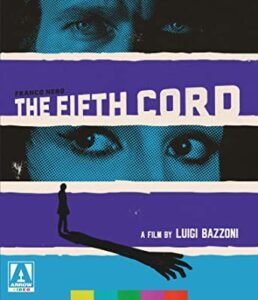
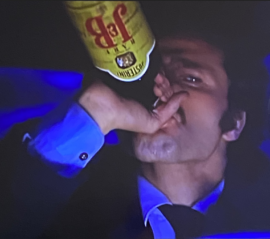
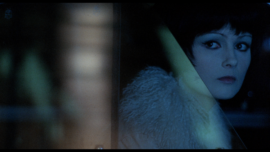
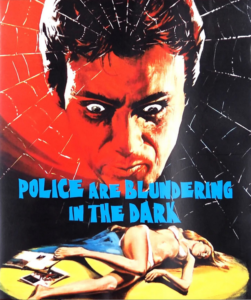
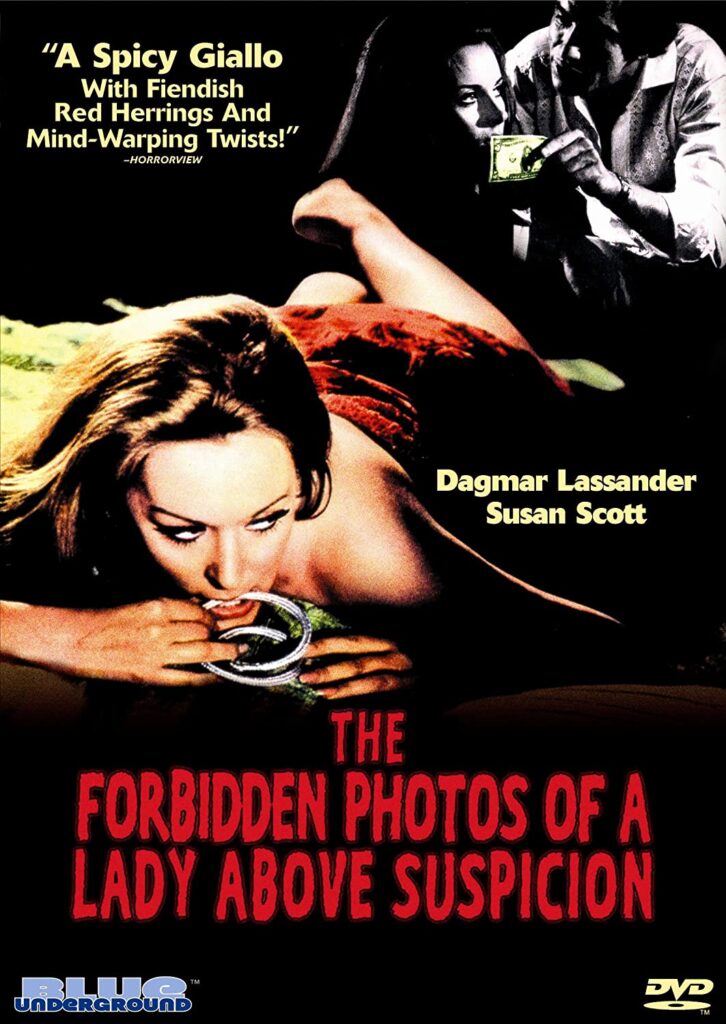
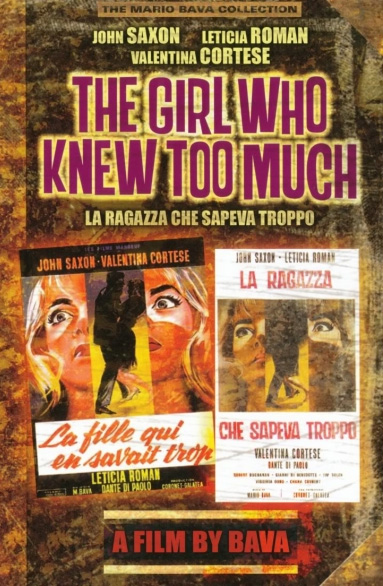
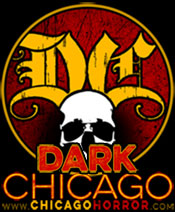
Pingback: 21 Nights of Giallo: Week One ~ John Everson
Pingback: 21 Nights of Giallo: Week Three ~ John Everson
Pingback: 2022: A Very Giallo Year! ~ John Everson